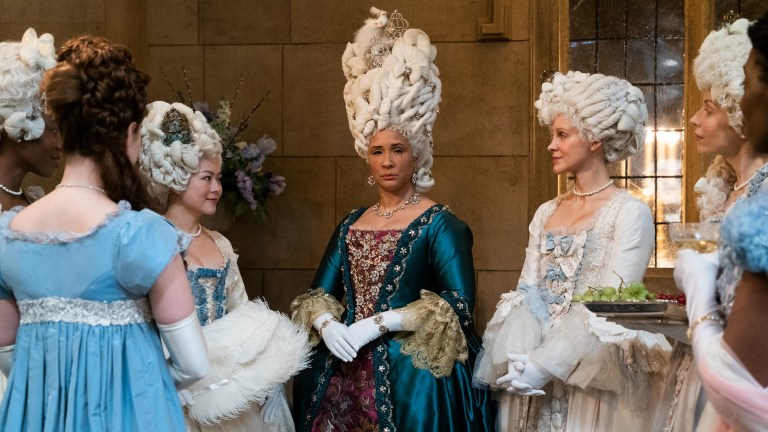TV and Movies Are Lying To You About Corsets – From Bridgerton to Pirates of the Caribbean and Beyond
Den of Geek speaks to fashion historians about the troubling trend of historically inaccurate women's garments.

In the first scene of Queen Charlotte: A Bridgerton Story, Charlotte (India Amarteifio) sulks in a carriage en route to marry King George. Her brother jokes that she hasn’t moved in six hours.
Charlotte scowls and responds: “The gown sits atop a bespoke underpinning made of whalebone. The problem with whalebone is that it is rather sharp. I am in the height of fashion, so this corset is quite snug. If I move too much, I might be sliced and stabbed to death by my undergarments. I am angry and I cannot breathe. Turn this carriage around or I will bounce. I will impale myself on this ridiculous corset and bleed to death.”
This monologue is great for setting up Charlotte’s feistiness. But Charlotte is very misinformed about her own underwear. European women in the 1760s called their structured undergarments “stays” not “corsets.” Stays weren’t made with bones from whales but with baleen from their mouths. Metal eyelets wouldn’t be invented for another 60 years, so the strings couldn’t have been pulled tight enough to restrict Charlotte’s breathing for six hours. She definitely could move, because 18th century women farmed, danced and rode horses in stays.
So, for Charlotte’s stays to kill her, she would have to do quite a lot more than “bounce.” Her threat is the equivalent of hopping in a bra until the underwire comes loose, slides through a cotton nightie, then pokes her until she bleeds to death. Charlotte might need to go back to the drawing board for her escape plan.
This trope is familiar to period drama obsessives. We’re used to heroines sobbing while domineering parent figures insist their corsets are pulled tighter. Think of Prudence in Bridgerton, Jinny in The Buccaneers, Mary in Downton Abbey or Rose in Titanic, all the way back to Scarlett O’Hara in Gone with the Wind. Corsets are nasty torture devices that women in the olden days were forced to wear so they would be skinnier for the male gaze, right?
Not really. So much of what film and TV taught us about corsets is wrong. Fashion historians tell Den of Geek which of our favourite shows get corsets right, and why cinema is so obsessed with women crying over their underwear.
Pirate and Prejudice
Western women wore stiffened bodices from the 1500s onwards, and called them “bodies” or “stays.” Stays distribute the weight of heavy skirts along the wearer’s torso and help them avoid muscle pain. Looking fashionable wasn’t as simple as looking skinny. If you visit an art gallery and study the portraits of posh people, you’ll see that society’s ideal woman had a different figure in each decade.
Pirates of the Caribbean: The Curse of the Black Pearl is set approximately in the 1740s (the ghostly monkeys and zombie octopus men and whatnot kind of make it hard to pinpoint an exact year). Elizabeth Swan’s father wants a suitor to fancy her. He gifts her a corset and insists, “It’s the latest fashion in London!” Elizabeth hisses, “Women in London must have learned not to breathe.” Later, the corset is so tight that Elizabeth swoons off a cliff. Jack Sparrow resuscitates her by slicing the garment open.
According to Dr. Hilary Doda, a fashion historian and author of Clothing in the Atlantic World 1650-1750, there’s not much historical evidence that Johnny Depp would need to rip off Keira Knightley’s underwear.
“It’s utter nonsense,” Doda says, “I have to be stopped from throwing pillows at the screen.”
Elizabeth is 50 years too early for the word “corset.” This item is a pair of stays, and both she and young boys would have worn them since they were two. Her father is three centuries behind on “the latest fashion in London.”
“Waist-cinching was not really part of the design of 17th and 18th century pairs of stays,” Doda says.
Assuming all women wanted to look as skinny as possible is projecting 21st century beauty standards onto the past. It seems pretty unlikely a “corset” would cause Elizabeth to fall into the ocean. Maybe she just fancied a swim?
The Viscount Who Laced Me
Bridgerton opens with Lady Featherington yelling, “tighter!” as an army of maids tug at the laces of her daughter Prudence’s corset. Her sister Penelope watches in horror. “Is she to breathe, Mama?” Prudence’s corset is so tight that she later faints at the Queen’s feet.
This scene makes no sense, because Prudence’s dress hides her stomach. The trend in the 1810s was for those Empire waist dresses you see in Jane Austen adaptations, where the skirt starts under the bust. Women in this era mostly wore short corsets that look more like modern bralettes than Elizabeth Swan’s stays.
Cassidy Percoco is a fashion historian and the author of Regency Women’s Dress. She says, “The corsets in Bridgerton do not create an accurate Regency figure. The natural roundness of the bust was of great importance to fashion. Each was pushed up and out. The Bridgerton corsets tend to flatten their wearer’s busts in order to produce a clear cleavage line down the middle of the chest, which is what’s currently considered the height of sexiness.”
In the teaser for Bridgerton season 3, the ladies dance with silhouettes like Hollister models, not Regency portraits.
The Bridgerton girls strip down to their underwear a lot, which is helpful for those of us analysing the historicity of their clothes. Daphne and Kate’s corsets are the right length, but worn incorrectly. Stays and corsets were designed to go over a lightweight shift dress, called a chemise. Daphne and Kate skip this layer. It’s the equivalent of going for a run with trainers and no socks – not comfy and very sweaty. No wonder Bridgerton actresses asked to wear bras in Season 3.
Gone with the Waist
Netflix series The Empress follows Elisabeth of Austria in 1853. Elisabeth looks nauseous as the strings of her corset are yanked tighter and tighter. “Please stop now,” she gasps, “I can’t breathe.” Her lady-in-waiting sneers. “Then it’s just right.”
Elisabeth is so perturbed she flounces off into the garden.
This scene is a great metaphor for the suffocating Hapsburg court. But in reality, Elisabeth shocked the Hapsburg court by using tightlacing to reduce her waist to 16 inches. The 2022 film Corsage depicts this really well.
Tightlacing is when you wear such compressive corsets that eventually your waist actually becomes narrower. The invention of metal eyelets in the 1820s meant that corsets could be tenser. Tightlacing became a bit more common in the Victorian era to achieve the trendy hourglass figure. It’s not too unrealistic for Gone with the Wind’s ultra-fashionable Scarlett O’Hara to squeeze into a narrow corset for a party in 1861.
However, studies of skeletons have shown that very few reshaped their torsos with corsets, and those who did had a normal life span. Scarlett O’Hara and Elisabeth of Austria are the exception, not the rule.
Why Do Period Dramas Make Corsets Look So Bad?
Dr. Kate Strasdin is a Senior Lecturer at the Fashion and Textile Institute. She explains, “the second wave feminist movement used 19th century womanhood as the arc of progress. This meant that for decades, the 19th century has been somewhat demonised and viewed as the pinnacle of female oppression. This was true in so many ways, but the corset was not necessarily one of them.”
20th century filmmakers used to cherry pick extreme things that Victorian men said about corsets, instead of looking more broadly at what women said about their corsets.
Hilary says, “there was a fairly popular genre of erotica in the 19th century that focused on the sexuality of tightlacing. It’s been suggested that there was a lot more porn about the thing than actual women doing the thing, which frankly doesn’t surprise me all that much.”
Dr. Doda suspects that the image of women clinging to bedposts while their corsets are tightened, like in Gone with the Wind, Titanic or Outlander, comes from 18th century cartoons. These images were meant to poke fun at aristocratic women, not show what they did each day.
The most extreme and eye-catching corsets get displayed in museums. Corsets are often fully laced up on mannequins, even though most women wore them with a two inch gap at the back.
Kate says, “It’s the same as taking a pair of seven inch high heels and using them a hundred years from now, to suggest that women wore those shoes all the time.”
Bridgerton’s Simone Ashley, The Great’s Elle Fanning and The Favourite’s Emma Stone have all complained recently about wearing corsets in period dramas. But their experiences on a TV set just aren’t the same as the experiences of women centuries ago.
The costume designer for Mary Queen of Scots told Page Six that “If you’ve got a whole court full of women, you can’t make every corset, so you wind up using some stock corsets and they’re maybe not going to be comfortable. But a bespoke corset really should be comfortable.”
Kate explains, “It is essentially a question of budget not comfort. What happens with period dramas such as Bridgerton is that they have to use stock underpinnings and so of course they will be a one-size-doesn’t-fit-all scenario.”
Why Care?
Yes, we know realism isn’t the priority in Pirates of the Caribbean. We saw Jack Sparrow water-ski with zombie sharks. And we get that Bridgerton is entertainment, not a documentary.
But when period dramas are the main way we engage with the past, it’s important we check out what really happened in that era. We don’t want to get it into our heads that women forced each other into embroidered torture devices for 500 years. We risk reducing women to passive victims or silly fashion fanatics, and that’s not fair to them.
Plus, when you binge Bridgerton in preparation for Season 3, you get the satisfaction of pointing out to your friends, “Actually, I read an astonishingly well-written article in Den of Geek. Charlotte couldn’t bleed to death by bouncing about in her underwear.”
